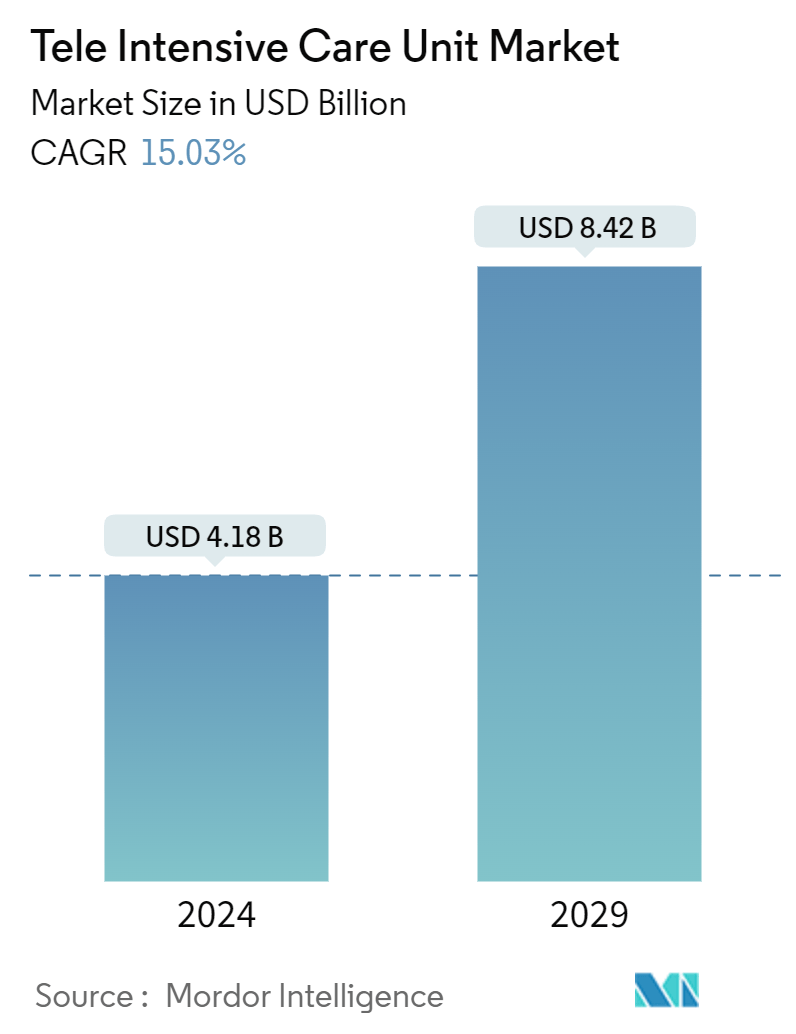Market Size of Tele Intensive Care Unit Industry

| Study Period | 2021 - 2029 |
| Market Size (2024) | USD 4.18 Billion |
| Market Size (2029) | USD 8.42 Billion |
| CAGR (2024 - 2029) | 15.03 % |
| Fastest Growing Market | North America |
| Largest Market | North America |
| Market Concentration | Medium |
Major Players
*Disclaimer: Major Players sorted in no particular order |
Tele-intensive Care Unit Market Analysis
The Tele Intensive Care Unit Market size is estimated at USD 4.18 billion in 2024, and is expected to reach USD 8.42 billion by 2029, at a CAGR of 15.03% during the forecast period (2024-2029).
Factors such as an increase in the volume of surgical procedures worldwide and increasing demand for remote patient monitoring are anticipated to drive market growth.
The rising prevalence of chronic diseases, coupled with the growing geriatric population, raises the need to find new ways of increasing access to care, improving patient outcomes, and reducing the cost of medical care. For instance, according to the Centers for Disease Control and Prevention (CDC), data updated in July 2022, in the United States, six in 10 adults suffering from a chronic disease, and four in 10 adults had two or more chronic diseases like heart disease, cancer, stroke, chronic obstructive pulmonary disease, and diabetes.
The growing aging population is expected to increase demand for patient monitoring at remote locations as the aging population suffers from chronic diseases that require intensive care units dedicated to the management of critically ill elderly, which is likely to boost market growth. For instance, according to the America Health Ranking data published in 2023, 58 million adults aged 65 and older lived in the United States in 2022, accounting for 17.3% of the nation's population. Thus, the expected increase in the number of elderly suffering from chronic diseases raises hospital admission rates. This is anticipated to fuel the demand for tele-ICU, propelling market growth.
Furthermore, the advantages offered by tele-ICU such as the low-cost method of connecting intensivists with hospitals, earlier interventions for critically ill patients, allowing hospitals to provide these highly trained specialists to their most critically ill patients, increased awareness of high-acuity patients for proactive monitoring, and improved care quality and adherence to key metrics increased their adoption across hospitals.
Moreover, the increasing launch of tele-ICU hubs in various countries is also expected to propel market growth. For instance, in May 2022, Manipur's Chief Minister inaugurated the first-ever Tele-ICU Hub, including a 10-bed ICU ward at the Jawaharlal Nehru Institute of Medical Sciences (JNIMS), Imphal. With the tele-ICU facilities, patients being treated at intensive care units (ICU) in different district hospitals and other tele-ICU-supported hospitals will be able to access observation by specialist doctors through the hub set up at JNIMS.
Therefore, owing to the factors above, such as the high prevalence of chronic diseases, the growing aging population, and the advantages of tele-ICU, the market studied is anticipated to grow over the forecast period. However, the high cost of treatment and setup is expected to hinder the growth of the tele-intensive care unit market over the forecast period.
Tele-intensive Care Unit Industry Segmentation
As per the scope of the report, tele-intensive care unit (ICU) is a diagnosis and treatment method where patients can get remote intensive care services through videoconferencing and internet technologies. Most tele-ICU programs feature command centers staffed with intensivists and critical care nurses who assist patients online via audio connections or videoconferencing. It enables medical personnel to access patient data instantly and address problems as they develop. Tele-ICU with the bedside team can provide support care for the patient without distractions and deliver timely interventions.
The tele-intensive care unit market is segmented by component (hardware [devices, communication lines, computer systems, physiological monitors, display panels, video feed, and other hardware], software, and services), type of management (intensivist, open, co-managed, open with consultants, and other types of management), and geography (North America, Europe, Asia-Pacific, Middle East and Africa, and South America). The market report also covers the estimated market sizes and trends for 17 countries across major regions globally. The report offers the value (USD) for the above segments.
| By Component | |||||||||
| |||||||||
| Software and Services |
| By Type of Management | |
| Intensivist | |
| Open | |
| Co-managed | |
| Open with Consultant | |
| Other Types of Management |
| By Geography | ||||||||
| ||||||||
| ||||||||
| ||||||||
| ||||||||
|
Tele Intensive Care Unit Market Size Summary
The tele-intensive care unit market is poised for substantial growth, driven by the increasing demand for remote patient monitoring and the rising prevalence of chronic diseases, particularly among the aging population. The COVID-19 pandemic acted as a catalyst, highlighting the importance of telemedicine in expanding critical care services. Government initiatives and private sector collaborations have further propelled the adoption of tele-ICU services, especially in regions with limited access to specialized medical professionals. The market is characterized by the benefits of cost-effective connectivity between intensivists and hospitals, early interventions for critically ill patients, and improved care quality. These factors, combined with the launch of tele-ICU hubs in various countries, are expected to sustain the market's growth trajectory over the forecast period.
North America is anticipated to maintain a significant share of the tele-intensive care unit market, supported by a well-developed IT infrastructure, robust communication networks, and a growing geriatric population. The region's market growth is further bolstered by the increasing prevalence of chronic diseases and various government initiatives aimed at enhancing remote monitoring systems. The introduction of advanced tele-ICU devices and software, along with strategic collaborations and partnerships, has expanded the availability and reach of tele-ICU services. Despite the competitive landscape, with moderate market consolidation, technological advancements and product innovations are enabling mid-size to smaller companies to strengthen their market presence. Key players in the market continue to drive growth through new product launches and strategic initiatives, ensuring a dynamic and evolving market environment.
Tele Intensive Care Unit Market Size - Table of Contents
-
1. MARKET DYNAMICS
-
1.1 Market Overview
-
1.2 Market Drivers
-
1.2.1 Increase in Volume of Surgical Procedures Worldwide
-
1.2.2 Increasing Demand for Remote Patient Monitoring
-
-
1.3 Market Restraints
-
1.3.1 High Cost of Treatment and Expensive Setup
-
-
1.4 Porter's Five Forces Analysis
-
1.4.1 Bargaining Power of Suppliers
-
1.4.2 Bargaining Power of Buyers/Consumers
-
1.4.3 Threat of New Entrants
-
1.4.4 Threat of Substitute Products
-
1.4.5 Intensity of Competitive Rivalry
-
-
-
2. MARKET SEGMENTATION (Market Size by Value - USD)
-
2.1 By Component
-
2.1.1 Hardware
-
2.1.1.1 Devices
-
2.1.1.2 Communication Lines
-
2.1.1.3 Computer Systems
-
2.1.1.4 Physiological Monitors
-
2.1.1.5 Display Panels
-
2.1.1.6 Video Feed
-
2.1.1.7 Other Hardware
-
-
2.1.2 Software and Services
-
-
2.2 By Type of Management
-
2.2.1 Intensivist
-
2.2.2 Open
-
2.2.3 Co-managed
-
2.2.4 Open with Consultant
-
2.2.5 Other Types of Management
-
-
2.3 By Geography
-
2.3.1 North America
-
2.3.1.1 United States
-
2.3.1.2 Canada
-
2.3.1.3 Mexico
-
-
2.3.2 Europe
-
2.3.2.1 Germany
-
2.3.2.2 United Kingdom
-
2.3.2.3 France
-
2.3.2.4 Italy
-
2.3.2.5 Spain
-
2.3.2.6 Rest of Europe
-
-
2.3.3 Asia-Pacific
-
2.3.3.1 China
-
2.3.3.2 Japan
-
2.3.3.3 India
-
2.3.3.4 Australia
-
2.3.3.5 South Korea
-
2.3.3.6 Rest of Asia-Pacific
-
-
2.3.4 Middle East and Africa
-
2.3.4.1 GCC
-
2.3.4.2 South Africa
-
2.3.4.3 Rest of Middle East and Africa
-
-
2.3.5 South America
-
2.3.5.1 Brazil
-
2.3.5.2 Argentina
-
2.3.5.3 Rest of South America
-
-
-
Tele Intensive Care Unit Market Size FAQs
How big is the Tele Intensive Care Unit Market?
The Tele Intensive Care Unit Market size is expected to reach USD 4.18 billion in 2024 and grow at a CAGR of 15.03% to reach USD 8.42 billion by 2029.
What is the current Tele Intensive Care Unit Market size?
In 2024, the Tele Intensive Care Unit Market size is expected to reach USD 4.18 billion.

